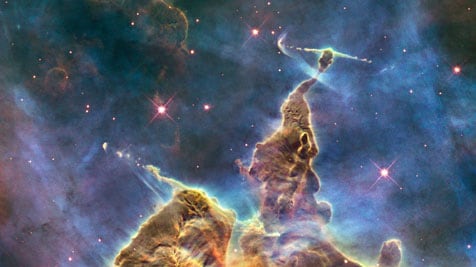
The NASA Hubble Space Telescope image captures the chaotic activity atop a three-light-year-tall pillar of gas and dust that is being eaten away by the brilliant light from nearby bright stars. The image celebrates the 20th anniversary of Hubble's launch and deployment into an orbit around Earth. Hubble was launched April 24, 1990.
NASA, ESA, and the Hubble Heritage Team
A composite photo of the galaxy M82 taken from three images snapped by the Great Observatories. The Hubble’s observations of hydrogen emission appear in orange, the data from the Chandra X-Ray Observatory is illuminated in blue, and the Spitzer Space Telescope recorded infrared light that shows up in red.
NASA, ESA, and the Hubble Heritage Team
The Hubble community bids farewell to the soon-to-be decommissioned Wide Field Planetary Camera 2 onboard the Hubble Space Telescope. In tribute to Hubble's longest-running optical camera, a planetary nebula has been imaged as WFPC2's final "pretty picture."
NASA, ESA, and the Hubble Heritage Team
To commemorate the Hubble Space Telescope's 19 years of historic, trailblazing science, the orbiting telescope has photographed a peculiar system of galaxies known as Arp 194. This interacting group contains several galaxies, along with a "cosmic fountain" of stars, gas, and dust that stretches over 100,000 light-years. The impressive blue stream of material is a "fountain" containing complexes of super star clusters.
NASA, ESA, and the Hubble Heritage Team
A powerful jet from a supermassive black hole is blasting a nearby galaxy. This never-before-witnessed galactic violence may have a profound effect on planets in the jet's path and trigger a burst of star formation in its destructive wake. This "death-star galaxy" was discovered through the combined efforts of both space and ground-based telescopes.
NASA, ESA, and the Hubble Heritage Team
This image shows the colorful "last hurrah" of a star like our Sun. The star is ending its life by casting off its outer layers of gas, which formed a cocoon around the star's remaining core. Ultraviolet light from the dying star then makes the material glow. The burned-out star, called a white dwarf, appears as a white dot in the center. Our Milky Way galaxy is littered with these stellar relics, called planetary nebulae.
NASA, ESA, and the Hubble Heritage Team
The graceful, winding arms of the majestic spiral galaxy M51 appear like a grand spiral staircase sweeping through space. They are actually long lanes of stars and gas laced with dust.
NASA, ESA, and the Hubble Heritage Team
Appearing like a winged fairytale creature poised on a pedestal, this object is actually a billowing tower of cold gas and dust rising from a stellar nursery called the Eagle Nebula. The soaring tower is 9.5 light-years, or about 57 trillion miles, high, about twice the distance from our Sun to the next nearest star.
NASA, ESA, and the Hubble Heritage Team
This image resembling Vincent van Gogh's painting, Starry Night, is Hubble's latest view of an expanding halo of light around a distant star, named V838 Monocerotis. The illumination of interstellar dust comes from the red supergiant star at the middle of the image, which gave off a flashbulb-like pulse of light two years ago. The star is located about 20,000 light-years away from Earth in the direction of the constellation Monoceros, placing it at the outer edge of our Milky Way galaxy.
NASA, ESA, and the Hubble Heritage Team
The Hubble Space Telescope has imaged striking details of the famed planetary nebula designated NGC 2818, which lies in the southern constellation of Pyxis (the Compass). The spectacular structure of the planetary nebula contains the outer layers of a star that were expelled into interstellar space. The glowing gaseous shrouds in the nebula were shed by the central star after it ran out of fuel to sustain the nuclear reactions in its core.
NASA, ESA, and the Hubble Heritage Team
Over 20 years ago, astronomers witnessed one of the brightest stellar explosions in more than 400 years. The titanic supernova blazed with the power of 100 million suns for several months following its discovery on Feb. 23, 1987. Observations made over the past 20 years by NASA’s Hubble Space Telescope and many other major telescopes have significantly changed astronomers' views of how massive stars end their lives. Astronomers credit Hubble's sharp vision with yielding important clues about the massive star's demise.
NASA, ESA, and the Hubble Heritage Team




